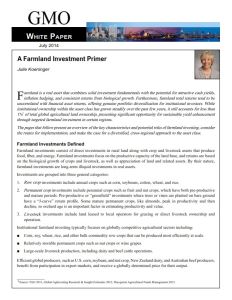加入 getAbstract 阅读摘要

加入 getAbstract 阅读摘要
Julie Koeninger
A Farmland Investment Primer
GMO, 2014
看看什么内容?
If you want to invest in farmland, read this report before plowing ahead.
Recommendation
The United Nations expects global demand for food to grow 60% by 2050. At the same time, investors are increasingly seeking out alternatives to the stock and bond markets. Given these conditions, as well as a recent history of strong returns and low volatility, it’s no wonder that investing in farmland has become increasingly popular with institutional investors. But those considering adding agriculture to their portfolios need to make careful choices before plowing ahead, advises investment strategist Julie Koeninger. Her information-packed article examines farmland investing, including its risks and rewards. getAbstract suggests her analysis to institutional investors and financial advisers who’d like to dig further into this asset class.
Summary
About the Author
Julie Koeninger is the product strategist for timber and agriculture at investment firm GMO.



















Comment on this summary